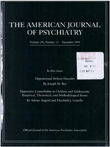Expenditures for psychotropic medications in the United States in 1985
Abstract
OBJECTIVE: Psychotropic medications have seldom been included in estimates of the costs of mental health services. In the infrequent case that these costs have been assessed, they have been estimated by using national surveys of consumers of health services. The objective of this study was to estimate the costs of prescriptions for psychotropic medications in the United States in 1985 and to assess the difference with the most recent cost estimate from a health services survey (1977). METHOD: Study data were based on retail costs of psychotropic medications reported to the Pharmaceutical Data Service Alpha National Prescription and Sales Audit. The data come from a computerized survey panel of 2,250 pharmacies representative of the more than 14,000 pharmacies nationwide. The database includes all medication prescriptions filled, whether paid with cash or Medicaid or reimbursed by third-party payment. Analyses were limited to psychotropic medication prescriptions. RESULTS: In 1985, $1.45 billion was spent on outpatient psychotropic medications. Nearly $868 million (60% of the total) was spent on antianxiety and sedative-hypnotic medications, while approximately $263 million (18%) was spent on antipsychotic medications, $240 million (17%) on antidepressants, and $84 million (5%) on combination psychotropic medications. These expenditures were much higher than would have been expected given the most recent health services estimate of $513 million. CONCLUSIONS: These results demonstrate the substantial cost of psychotropic medications in 1985. The finding that the cost of psychotropic medications was so high, in contrast to the lower estimate from the 1977 survey, demonstrates the importance of obtaining more frequent cost estimates and basing future estimates on medication databases.
Access content
To read the fulltext, please use one of the options below to sign in or purchase access.- Personal login
- Institutional Login
- Sign in via OpenAthens
- Register for access
-
Please login/register if you wish to pair your device and check access availability.
Not a subscriber?
PsychiatryOnline subscription options offer access to the DSM-5 library, books, journals, CME, and patient resources. This all-in-one virtual library provides psychiatrists and mental health professionals with key resources for diagnosis, treatment, research, and professional development.
Need more help? PsychiatryOnline Customer Service may be reached by emailing [email protected] or by calling 800-368-5777 (in the U.S.) or 703-907-7322 (outside the U.S.).



